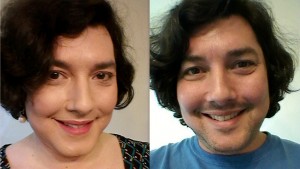I’ve written here before that I believe most transgender people share the same basic feelings: gender dysphoria, transgender desire and gender fog. Whether you are transsexual, transvestite, drag queen, drag king, butch lesbian, genderqueer, non-binary or something else, you almost certainly experience one of those feelings, and probably all three. Whatever neurological claims you may have read about essential differences between one group and another, the fact remains that almost none of the trans people you will meet have been found to have a “female brain,” neurologically. People cross those subcategory boundaries all the time, and the only evidence currently accepted for membership is personal declaration.
We are the same, and yet we can be divided into two subgroups that are very different, with an essential conflict of interest between us that is impossible to erase. This difference is not based on biology or neurology, it is based on a simple difference of goals. Trans people who transition – who take a goal of becoming or being seen as a different gender – are often at odds with trans people whose goals do not include transitioning.
There are multiple conflicts between transitioners and non-transitioners, but the most common, the most salient, conflict is over destiny. Transitioners tend to believe that it is their destiny to transition, and to interpret facts as evidence for that destiny. Non-transitioners may believe that it is our destiny not to transition, or we may be agnostic on that issue.
For example, one time I was out with a friend, presenting as a woman. My friend remarked to me, “You’re not very feminine, are you?” At first I was hurt, but then I saw he had a point, and I thought to myself, “Actually, I’m getting tired of being a woman, and I’ll be glad when I can take this bra off and use my regular voice. Good thing I didn’t transition!” In contrast, Lal Zimman interviewed trans men who reported feeling devastated by the idea that they were failing as men. They couldn’t say, “good thing I didn’t transition,” because they did. Instead, they said things like, “I must just be a feminine man.”
And you know what? I completely understand the value of the destiny argument. Transition is hard. I’ve known transitioners for whom it was pretty obvious to everyone that they were on the right path, but still they encountered some very daunting challenges. There are many people who are politically and philosophically opposed to transition, and who will fight you on it, possibly including parents, employers and medical professionals. It’s hard to go through that constantly wondering if you’re doing the right thing.
The psychologist Dan Gilbert talks about an experiment where people who felt that they were stuck with a possession (an artistic print) decided that they liked it better than people who thought they could exchange it. When we’re stuck with something – and it’s something we can live with – we make peace with it. When we can change it at any time, the grass is always greener. Marriage works in similar ways. If you’re committed to a person it helps to believe that you’re destined for them, and if you’re committed to transitioning it’s helpful to believe that you’re destined to transition.
The conflict comes in when people start making universal destiny arguments, like the idea that “trans women are women,” not just when presenting as women, but essentially, eternally, from birth through death, whether we transition or not. Transition then is portrayed as not a change of gender, but as revealing the “real you,” or your “authentic self.” That implies that someone like me who chooses not to transition is hiding the real me, or denying my authentic self. And that is true for people who stay in the closet, but it’s not true for the rest of us.
If we are not denying our authentic selves, but we are still not transitioning, many conclude, we must not have that essence of womanhood (or manhood) that makes transition such a necessity. And that leads to bizarre twists of logic, where someone can be a “man who likes to wear dresses” one day, and be seen as essentially and forever male, and the next day declare a transition and be seen as essentially and forever female.
This essentialist view of non-transitioners leads people to declare that we are not truly trans, and therefore not part of LGBT. It leads them to deny the very real feelings of gender dysphoria, transgender desire and gender fog that we continue to feel, and to deny us any need for support or services. It leads them to speak on behalf of all transgender people, setting priorities and making declarations about terminology without any regard to our very real needs.
Transgender essentialism also leads people to marginalize and ignore non-transitioners. Because the choice not to transition results in people tending to become less passable over time, non-transitioners are caricatured as embarrassing, and negative characteristics that are found across the transgender spectrum are pushed into caricatures of cross-dressers and drag queens as big clumsy insensitive objectifying men in short skirts, and of transmasculine genderqueer people as childish “transtrenders” who claim gender variance only to attract attention.
Detransitioners are usually kicked right out of the transgender club. The fact that they weren’t happy with their transition leads many people (including many detransitioners themselves) to declare that they were “never really trans” in the first place. But of course the feelings of dysphoria and desire and fog don’t vanish, and the detransitioners are left to cope with them with very little support.
In short, the essentialist way of thinking about trans issues is a big problem for non-transitioners and detransitioners. I used to think that it was just confined to a particular subgroup, and I had friends, many of them non-transitioning trans people, who were skeptical of it. But then a funny thing happened. Many of these friends transitioned, and as each one began to commit to building new lives in a new gender they and their families started repeating essentialist claims. Each time I heard one of these claims I objected, but the result was that over time they began to think of me as a combative stickler. This pattern is repeated in most of my interactions with transitioners.
I used to take some of this personally, but now I realize that the transitioners are just protecting their interests. They don’t seem to be capable of realizing how much their actions threaten my interests (this kind of egotism is a hallmark of gender fog), and thus they tend to dismiss my complaints as cranky contrarianism.
It is not cranky contrarianism. It is the one essential difference between trans people who transition and those who don’t: transitioners have an interest in justifying transition, and non-transitioners often have an interest in justifying not transitioning. It is not biology, it is simple psychology.
Can we still be friends? Yes, despite this difference, we have many of the same feelings, and many of the same needs. We face many of the same dangers, and we inhabit many of the same spaces. I have friends who have transitioned or are transitioning, and I respect their choices about what path to follow. (That is all I can do; I cannot accept that they have no choice. I think this is clear.)
There is room for us to form alliances of common interest, and alliances of the hearth. But there will always come a Yalta, a time when that essential conflict of interests will manifest itself, when the alliances will break down. Some people – Righteous Ones – will be able to put things in perspective and sacrifice their own interests for someone with a greater need.
It will not always be obvious whose need is greater, and we may take actions that are at odds with each other’s interests. But what is absolutely critical is to acknowledge and respect them. If a transitioner tells me that something I do or say affects her interests, I may keep doing it, but I will try to accept that the conflict exists and respect her interests. I ask the same from transitioners. If we all do that, there’s a chance we may be able to stay friends and keep the door open to future alliances.






